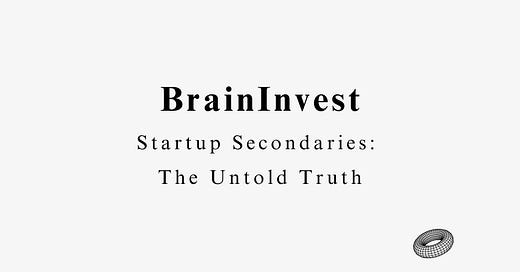Startup Secondaries: The Untold Truth
Thank you to all our subscribers! Share your link to unlock some perks — and don’t miss the surprise at the end! 🫶
Before diving into this paper, if you’ve worked with the Evergreen model in VC or if it piques your interest — send me a message! 😉
Picture this: someone offers you the chance to buy stock options (BSPCE) in a promising European startup. You jump on it. A few months later, the startup gets acquired, and… nothing. Not a dime. Those “shares” you were so excited about? Worthless. Why? Your name was never on the cap table.
This isn’t a one-off horror story — it happens more than you think. That’s why I want to share why startup secondaries both fascinate and frustrate me.
What’s a “secondary market” anyway?
Let’s break it down. Startups need money to grow, so they bring in investors (BA and VCs) and sometimes hand out stock options (like BSPCE) to keep their team motivated. Sounds great, right? Except… these shares aren’t liquid. Selling them can feel like trying to sell a house in a flood zone.
Here are your only real options:
A new funding round: Founders let investors sell or swap shares.
An acquisition (M&A): Another company buys the startup.
IPO: Taking the company public (the dream, but let’s be real, it’s rare).
Outside these scenarios, selling shares is nearly impossible. Enter the secondary market, a side hustle for buying and selling startup shares without waiting for those big liquidity events.
The rise of secondaries: Game-changer or a trap?
Some smart folks saw the liquidity problem and decided to build a market around BSPCEs, offering over-the-counter sales. Cool idea, right? But this quickly turned into the Wild West.
What went wrong?
Sales happened behind founders’ backs.
Shares were sold before they even existed.
Contracts included nasty clauses like ROFR (Right of First Refusal).
One famous case? A California startup discovered that 5% of its shares were sold to random individuals without approval, causing a total cap table mess. These disasters forced founders and VCs to step in and professionalize the secondary market.
A booming industry takes shape
Fast forward a few years, and the secondary market looks a lot more polished — thanks in part to VCs. With acquisitions becoming rare and IPOs almost mythical, startups and investors embraced SPVs (Special Purpose Vehicles) to keep the secondary engine running.
Take SpaceX and Stripe as examples. These private giants use SPVs to provide regular liquidity windows for employees and investors. The result? They stay private while refreshing their cap tables.
Even big players like Coller Capital are cashing in. This isn’t just a niche — it’s a major industry.
How to avoid rookie mistakes
If you’re thinking of diving into the secondary market, here’s a checklist:
Where are these shares coming from?
If it’s through an SPV, what’s the connection to the original startup?
What are you actually buying?
Are you on the startup’s cap table or just part of the SPV?
What rights do you have post-purchase?
The legal rule is simple: if it’s not written down, it doesn’t exist. No paper trail? You’re invisible.
Why I’m cautious about secondaries
Let’s be real — I’m not saying “never.” But two major red flags make me hesitate:
Crazy valuations:
Half the secondary deals I see are wildly overpriced — sometimes 2-3x the startup’s actual value. If the deal isn’t led by a founder or a trusted VC, I don’t even bother looking.
Ridiculous fees:
Secondary markets are a goldmine for some. Entry fees, management fees, transaction fees — it all adds up. And for what? Bragging rights on LinkedIn with a flashy startup logo? That doesn’t align with my “why.”
So… should you invest in secondaries?
The secondary market is crucial for startups, but don’t jump in blindly. My advice? Partner with the pros. Specialized funds like Coller Capital or HarbourVest know how to assess these deals and play the long game.
If you’re going solo, do your homework. Secondaries can be a great way to diversify your portfolio, but they demand more diligence than your average investment.
As Warren Buffett says: “Risk comes from not knowing what you’re doing.”
And remember: if someone’s hyping it up in your Uber ride, the opportunity’s already gone. 😉
🎁 To celebrate the end of the year, Enky and BrainInvest are offering you a €100 to €300 credit on your first investment with Enky Invest — the alternative investment platform that lets you fund sustainable furniture projects with returns ranging from 6% to 8.5%. Don’t miss out! Simply sign up on the platform here to claim your credit.
Thanks a bunch for reading this far! Feel free to share this edition (and the previous ones) and enjoy lots of perks: stickers, caps, access to events…
Previous articles you'll love :
Catch you soon!



